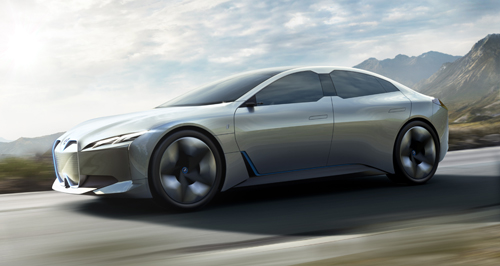Make / Model Search
News - BMWi Division not falling behind EV rival roll-out: BMWNext up: The Chinese-built all-electric iX3 will be the next ‘i’ model to launch in 2020. BMW i claims that i3 head-start benefits forthcoming iX3, i4, iNext30 Apr 2018 By DANIEL DeGASPERI in MAJORCA BMW i Division executives have rejected suggestions that the car-maker is falling behind rivals in the roll-out of electric vehicles this year, despite conceding that buyers will have to wait until 2020 for the iX3 and 2021 for the i4 and iNext. It has been five years since the i Division was born with the i3 hatchback, while the i8 followed in 2014, however BMW has worked to introduce i Performance derivatives of mainstream models only since then. This is despite the stand-alone Audi e-tron and Jaguar I-Pace launching imminently to rival the Tesla Model X into the burgeoning EV SUV market – leaving BMW with a wait time of two years before the Chinese-made iX3 EV lobs. Indeed within three years the current duo of i Division models – i3 and i8 – will more than double to include the iX3, and then the i4 medium-sized five-door and the iNext in the same liftback form, but with a driver-less technology focus. Speaking at the international launch of the i8 Roadster in Majorca, Spain, last week, BMW i media relations manager Paloma Brunckhorst said that the car-maker had not fallen behind rivals and indeed Audi and Jaguar have been behind BMW in only now introducing their first EV – something it did with i3 in 2013. “We are on the market already for five years, last year we sold one hundred thousand electrified vehicles for our brands, they (Audi and Jaguar) are doing the first step now, whereas now we are by far ahead,” Ms Brunckhorst said. “And we started early, so we have quite a lot of experience in all this, so we are not starting from zero we’re starting with six plug-in hybrids cars, one plug-in hybrid BMW i, one electric BMW i, so we have much experience. “And next we want to sell 140,000 electrified cars, we’re the leader in electric mobility and we want to still be that in the next year. And I think with these cars also in the next years we’re going further and further.” With BMW i and i Performance sales totalling 100,000 vehicles last year, the 40 per cent increase in sales expected this year has been tipped to come from newly introduced plug-in hybrid EVs such as the overseas-only 225xe iPerformance version of the 2 Series Active Tourer. But even the older i3 has been on the rise. “i3 is growing and growing, we hope that after this year we sell more than last year,” Ms Brunckhorst said. “And the plug-in hybrids are really important because it’s the technology for people who don’t want to start directly with the battery electric vehicle because it doesn’t fit in their lives for example. “Or, they want a car that has more range and they have more flexibility. Because the i3 is not the perfect car for everyone, for sure.” Last year, however, only one-third of i3 sales have been for the full EV, with the remaining majority choosing the pricier petrol-engine range extender version. The introduction of the iX3 in 2020 – shown last week in ‘concept’ form at the Beijing motor show – will not only become the first BMW i Division model to debut since the i3 and i8, but it will also be the first to share its chassis and styling with a mainstream BMW model (in this case the X3 medium SUV). The sudden expansion of BMW i Division models has been linked to such shared platforms, as the era of a stand-alone carbon-fibre-intensive chassis specific to i3 and i8 comes to a close. The other two new models, the i4 and iNext based on last year’s Frankfurt motor show i Vision Dynamics concept, will be based on the same Cluster Architecture (CLAR) as the X3, 5 Series, 7 Series and even the X7. BMW i8 project manager Markus Plunkte insisted that the iX3 was a proper i Division vehicle despite its shared looks and chassis. GoAuto understands that both CLAR and its front-wheel-drive UKL equivalent (for Mini, 2 Series Active Tourer, X1, and next 1 Series) have been future-proofed to be able to provide petrol/diesel internal combustion engine (ICE), plug-in or full EV derivatives. “It is a proper i model (and) iX3 really will be the final name, so it is a proper BMW i model,” Mr Plunkte told GoAuto at the i8 Roadster launch. “It is based on the X3 which is a very successful model, and also like to access broad customer groups I think that makes sense. The iX3 (will arrive) in 2020, there will be in 2021 the iNext coming as a really huge step for highly automated driving (and) the i4 already pronounced to go into series production. “So the brand is growing and it is growing quickly as our customers and also the demand for it, so I think we are a proper growing family with BMW i products. Using the fifth-generation of BMW’s eDrive system, the iX3 Concept used a 70kWh battery to power a 200kW electric motor and provide over 400km of driving range between recharging (of just 30 minutes on a 150kW fast-charge). While the platform mirrors the X3, the chassis features its own unique rear subframe and battery packaging assembly, which will likely differentiate the more affordable i4 and flagship iNext from its 5 Series platform donor.  Read more16th of February 2018  BMW i shifting focus from electrification to autonomyAutonomous cars, not EVs to carry on the BMW i sub-brand into the future20th of September 2017  Frankfurt show: BMW says EV rollout unstoppableMore electrified BMWs headed to Aus, regardless of federal government assistance |
Click to shareBMW articlesResearch BMW Motor industry news |











Facebook Twitter Instagram